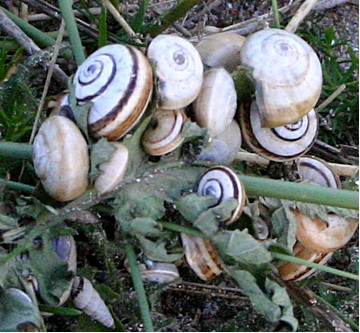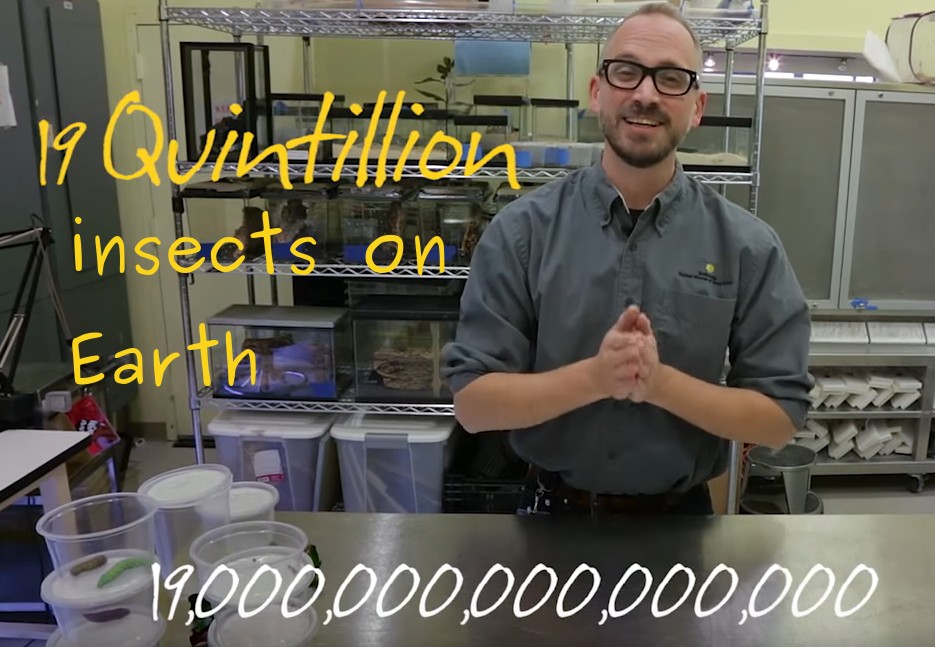Lincoln Index activities
Estimating Animal Populations using the, "Capture - Mark - Release - Recapture" method.

How do biologists make estimates of the number of giant pandas left in the wild? Because animals often move and hide this task is really difficult but the Lincoln index provides a solution. In this activity students collect two samples of animals and use this clever method to estimate a population. It can be carried out as fieldwork outside of school, in the school grounds or as a lab activity using beans as animals in a tray of sand.
Lesson resources
 Guiding Question
Guiding Question
How can we estimate a population size when we cannot
possibly count the all of the animals individually?
For example, someone must have estimated this claim that there are
19 quintillion insects on earth.
Activity 1 - Estimating a population - lab activity.
In this simple lab activity students use random sampling to estimate a population of small animals in a sandy ecosystem..
The ecosystem is modelled by a tray of sand and the animals will be dry beans.
We can imagine the beans to be 'monster rice rats', 'red peeping frogs' or 'white rhinos'. These are all endangered species.
Method
- Collect a handful of beans (between 50 and 100 beans) and mix them in the sand to hide them.

- Place a ruler on each edge of the box.
- Using random coordinates place a biscuit cutter onto the sand and dig out all the bean 'animals' using a spoon
- Repeat this sampling procedure until you have collected at least 12 bean 'animals'. Then stop collecting.
- Record the total number of bean 'animals' collected in this Sample 1
- Mark all the bean 'animals' bu putting a cross on them with a marker pen.
- Release all the bean 'animals' back into the sand.
- Give the sand a good stir to mix the bean animals.
- Take a second sample in exactly the same way as you did before.
If you did 3 biscuit cutter quadrats in sample 1, do the same number for sample 2. - Count the number of beans in the second sample.
- Also the number of marked beans that you have re-captured.
- Follow the calculation of the Lincoln-Peterson Index to make your estimate of the animal population.

N = Population estimate
M = Marked organisms released
S = Second sample size
R = Number of animals recaptured (in the second sample
- To complete the exercise sieve all the sand into a bucket, catching all the beans.
- Count the total actual population of bean 'animals'.
This value will illustrate how accurately the Lincoln index has estimated the population.
Follow this ![]() Lincoln index lab activiy worksheet.
Lincoln index lab activiy worksheet.
Activity 2 - Estimating a wild population - field activity
In this activity students will see how the Lincoln-Peterson index can be used to estimate real animal populations in the field.
There are several easy methods of sampling animals:
- Pit fall traps could be set up in the school grounds (left for several hours),
- Snails could be captured from a pile of stones or a wall by hand.
- Grasshoppers could be caught in a grassy meadow in summer.
Whatever animals are easy to catch, and mark without causing harm will work for this experiment.
![]() Lincoln index student fieldwork worksheet
Lincoln index student fieldwork worksheet
Activity 3 - The Lincoln index - IB Style questions
In May 1930 Frederick C. Lincoln wrote an article which suggested a method of estimating waterfowl population size which had never been used before.
Calculating waterfowl abundance on the basis of banding returns, F. C. Lincoln 1930
Lincoln was concerned about the conservation of waterfowl (ducks). He wanted to know whether hunters were taking more ducks than the populations could support. In some places there had been reports of a decline in bird numbers, and he wanted a method of estimating the continental population as a whole. Draining of wetlands for agriculture was also taking place.
Complete the calculations and questions on this ![]() Estimating populations IB style questions worksheet
Estimating populations IB style questions worksheet
Teachers notes
Activity 1 - Lab activity
- The lab activity takes about 30 minutes and is a good way to introduce the Lincoln index.
- Counting the beans at the start is optional, some students may prefer to estimate an unknown quantity.
- The lesson could be used as an introduction to real fieldwork using the Lincoln index.
- It can be extended by making repeat estimates using different sample sizes, and different amounts of mixing to illustrate the assumptions on which the Lincoln index is based.
Each group of students needs;
- One plastic tray containing 1cm depth of dry fine sand.
- Approximately 100 beans (chick peas or rice also work)
- 1 sieve (or tea strainer) which allows the sand to pass through
- 1 marker pen, or white correction pen
Students sample with a small quadrat, or a biscuit cutter, preferably using random coordinates.
They mark each bean they find with a pen, and release it back into the sand.
The tray is mixed thoroughly after release of the ‘beans’ before the second sample.
A second sample is taken using the same sampling method (same number of quadrats).
The final stage can be sieving the sand to find all the hidden chick peas, and checking the precision of the estimate by finding out the total number of beans in the tray.
Activity 2 - Field activity.
There are so many ways to sample animals in the field that it is impossible to describe them all. The principal that the same effort should be used to catch the first and the second sample is important for the accuracy of the estimate.
The worksheet will probably need to be adapted to the specific details of the field work undertaken.
Activity 3 - IB style questions
These questions aim to illustrate the work of Lincoln in monitoring ducks in the USA in the 1930s. He wasn't the first scientist to document this method, others before him include, the Danish marine biologist Petersen who used it in 1895 with tagged fish, and Dahl marked brown trout in a small Norwegian lake in 1917.
It is sometimes called the Petersen-Lincoln method.
Ref: Petersen, C. G. J. (1896)"The Yearly Immigration of Young Plaice Into the Limfjord From the German Sea", Report of the Danish Biological Station (1895), 6, 5–84
Model answers can be found for the IB style questions here. Lincoln index - model answers

 IB Docs (2) Team
IB Docs (2) Team
